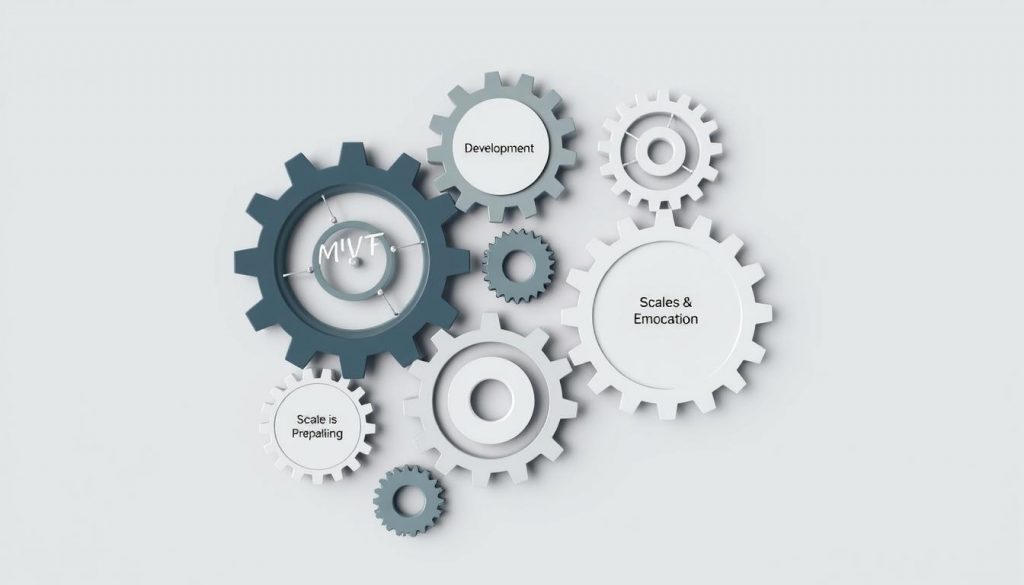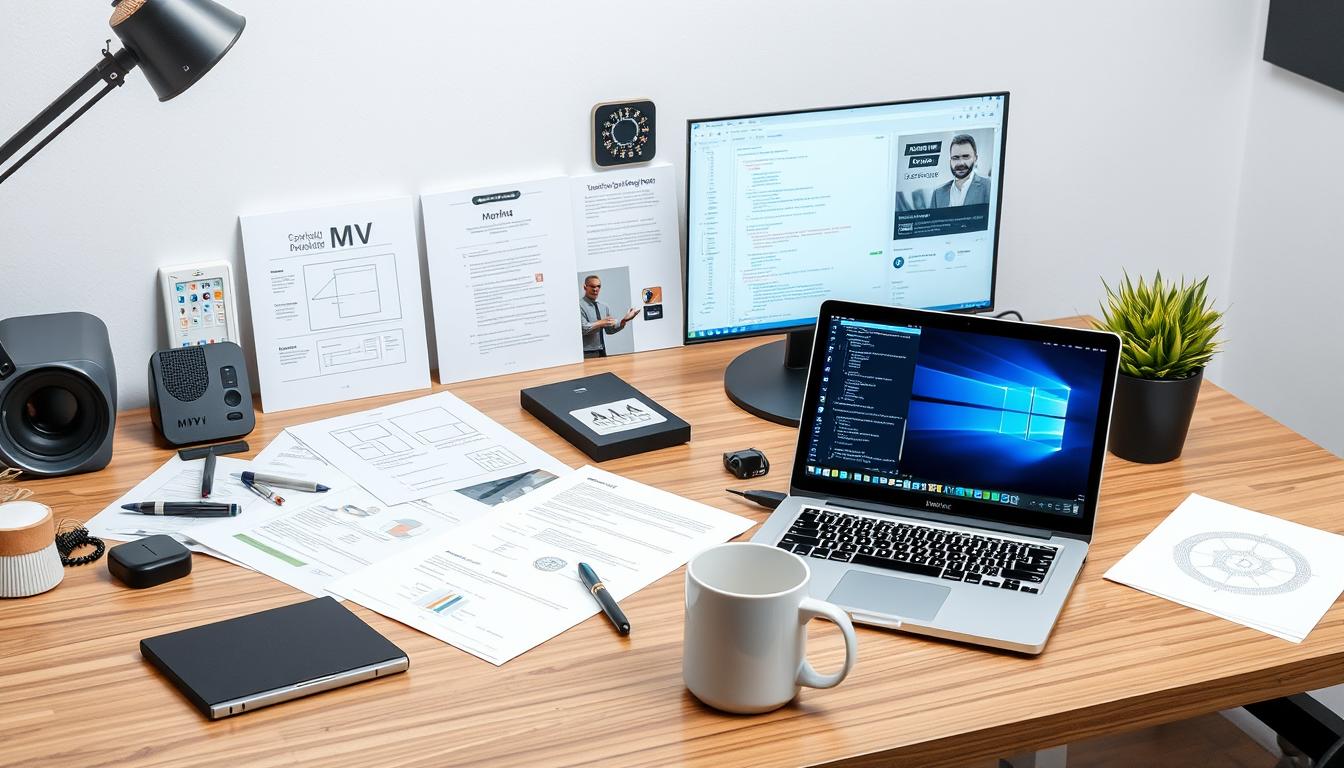What if your startup’s Minimum Viable Product (MVP) could be the key to unlocking success, but common mistakes hold you back? Developing an MVP is a key step for startups. It lets them check if their idea works, attract investors, and test the market. Many successful companies started with an MVP, and avoiding common pitfalls can save time, money, and effort in custom application development.
Startups create an MVP to please early customers and get feedback for future work. This is vital in mobile app MVP. By knowing what an MVP is and why it’s important, startups can set themselves up for success. Avoiding mistakes early on can make a big difference in MVP development best practices and custom application development.
Key Takeaways
- Avoiding common mistakes in MVP development can save time, money, and effort.
- MVP development best practices are key for startups to succeed.
- Custom application development needs careful planning to avoid pitfalls.
- Mobile app MVP is a key step in testing the market and attracting investors.
- Understanding the importance of an MVP can help startups make informed decisions.
- MVP development best practices can help startups create a successful product.
- By following mvp development best practices, startups can increase their chances of success.
Understanding the MVP Development Process
The concept of a Minimum Viable Product (MVP) has changed how companies make mobile apps. An MVP has just enough features to please early users and get feedback for later. Airbnb is a great example, starting as an airbnb mvp case study and becoming a global hit.
The mvp development process makes a fully working product to test with users. It lowers risks, saves time and money, and gives useful feedback for growth. By launching an MVP, companies can test their product, get feedback, and improve it based on data.
Some key benefits of mvp development include:
- Reduced risk: By launching a minimal product, companies can test their idea without investing too much time and money.
- Fast feedback: An MVP allows companies to gather feedback from users and make improvements quickly.
- Cost-effective: mvp development is often less expensive than traditional mobile app development methods.
Companies like Airbnb and Dropbox have used mvp development to launch their products and succeed in the market. By following this approach, companies can create a successful product that meets their target audience’s needs.
1. Common Pitfalls in MVP Development Best Practices
Many developers and entrepreneurs face common challenges in mvp best practices. One big mistake is aiming for a perfect product instead of a minimum viable one. This can cause too many features and higher costs.
Here are some common mistakes in mobile app mvp development:
- Not checking if the product meets user needs, leading to a product that doesn’t fit the market
- Not using agile development, making the process too rigid and inflexible
- Ignoring user feedback, causing the product to not meet changing user needs
To steer clear of these issues, it’s key to stick to mvp best practices. Focus on custom application development that really meets user needs. This way, developers can make successful mobile app mvp development projects. These projects can help businesses grow and keep customers happy.
2. The Technology Stack Dilemma
Choosing the right technology stack is key when making a minimum viable product (MVP). The stack’s impact on scalability, maintainability, and performance is huge. In mobile app development, the right stack can speed up development and deployment. The wrong one can cause delays and higher costs.
In web app MVP development, the choice is just as critical. Traditional stacks like LAMP are solid but might not fit modern needs. Modern stacks, like MEAN, offer more flexibility but need more expertise. No-code solutions, like Bubble and Adalo, are great for quick MVPs, needing little coding knowledge.
For an ai-powered mvp, scalability and performance are top priorities. The stack must support AI features like machine learning. The right stack ensures the MVP is scalable, maintainable, and performs well, paving the way for success.
Choosing Between Traditional and Modern Stacks
The choice between traditional and modern stacks depends on the MVP’s needs. Traditional stacks work well for simple web apps, while modern ones are better for complex, scalable ones. No-code solutions are ideal for fast prototyping and deployment.
When to Use No-Code Solutions
No-code solutions are great for MVPs needing quick prototyping and deployment. They’re also good for small teams or those with limited resources. But, they might not fit complex, scalable apps needing deep customization.
Scalability Considerations
Scalability is vital when picking a technology stack for an MVP. The stack must handle more traffic and users without slowing down. A scalable stack ensures the MVP can grow with its user base.
3. Feature Bloat: The Silent MVP Killer
Feature bloat is a major problem in mvp development. It happens when a product has too many features. This makes it slow, complex, and hard to use. For mobile app mvp, it’s even worse because users want a smooth experience.
To prevent feature bloat, focus on the essential features. Identify what users value most and cut the rest. Custom application development helps tailor a solution that fits your needs without losing usability.
Here are some ways to avoid feature bloat:
- Do user research to find out what they really need.
- Choose features based on what users say and your business goals.
- Keep checking with users to make sure your product is right for them.
By being thoughtful and user-focused in mvp development, you can make a great mobile app mvp. It will meet your audience’s needs without the problems of feature bloat. Focus on custom application development and making it easy to use. This way, your product will be both useful and fun to use.
| Feature Bloat Symptoms | Consequences |
|---|---|
| Complex and slow product | Negative user experience |
| Too many features | Difficulty in use |
| Poor user feedback | Low adoption rates |
4. Market Research and Validation Errors
When making a minimum viable product (MVP), it’s key to do market research and validation. Understanding the target audience is vital to make an MVP they’ll love. Dropbox’s MVP case study shows how important it is to check your assumptions before you launch.
In mobile app development, mistakes in market research and validation can cost a lot. To avoid these, do deep market research, check your product with users, and use data to guide your choices. This is where mvp best practices help, giving a clear path to follow.
Some common mistakes in market research and validation are:
- Not understanding the target audience
- Not doing a competitive analysis
- Not making choices based on data
By sticking to mvp best practices and avoiding these mistakes, developers can make a successful MVP. This can lead to a great product launch and set the stage for growth.
| Market Research | Validation | Outcome |
|---|---|---|
| Conduct thorough market research | Validate product with users | Successful MVP launch |
| Do not understand target audience | Do not conduct competitive analysis | Unsuccessful MVP launch |
5. Resource Allocation Challenges
Getting resources right is key in mvp development. Too many resources on non-essential features waste time and money. Not enough on key features means a poor product. It’s vital to prioritize and manage resources well.
In custom application development, managing resources is tough. With many features to handle, it’s easy to lose focus. By focusing on the most important parts and using resources wisely, developers can succeed in mobile app mvp development.
Common challenges in mvp development include:
- Insufficient resources for critical features
- Over-allocation of resources to non-essential features
- Lack of clear understanding of resource requirements
Knowing these challenges helps developers succeed in mvp development. They can make sure their product meets user needs.

6. Testing and Quality Assurance Oversights
In mobile app development, testing and quality assurance are key. They can make or break an MVP’s success. Without them, a poor user experience can lead to low engagement and retention.
To avoid these mistakes, it’s vital to follow mvp best practices. This includes thorough testing and integrating user feedback. This way, developers can find and fix issues early, ensuring the MVP is up to standard.
Essential Testing Protocols
Important testing protocols include unit testing, integration testing, and user acceptance testing. These ensure the MVP works as expected and meets standards.
User Feedback Integration
User feedback is essential in MVP development. It helps developers find areas for improvement and make informed decisions to enhance the user experience.
Performance Metrics That Matter
Key performance metrics include user engagement, retention, and satisfaction. Monitoring these helps developers understand their MVP’s success. If you need help with mvp development, contact us for mvp development and let us guide you.
7. The User Experience Factor
In mvp development, the user experience is key. It can decide if a product succeeds or fails. A great user experience means the product is simple, easy to use, and meets the audience’s needs.
When making a custom application, knowing what users want is vital. This ensures the product connects with them.
A top-notch mobile app mvp focuses on user experience. It considers how easy it is to navigate, how it looks, and how well it works. Developers use user research and create user personas to understand their audience better.
This knowledge helps them make design choices that meet user expectations.
Improving user experience in mvp development involves several steps:
- Conducting user research to inform design decisions
- Creating user personas to guide development
- Testing the product with users to gather feedback and iterate
By focusing on user experience and using these strategies, developers can make a mobile app mvp that users love. This sets the stage for long-term success.
8. Scaling and Infrastructure Planning
Scaling and infrastructure planning are key when making a successful MVP. By following mvp best practices, developers can make sure their product grows well. This is very important in mobile app development, where it helps handle more users.
Managing technical debt is also important. It means fixing issues that can slow down the product. An ai-powered mvp can help with this, making the product more efficient.

To get ready for growth, developers need to plan ahead. They should invest in scalable infrastructure and hire the right people. By doing this, they make sure their MVP can handle more users.
Some important strategies for growth include:
- Investing in cloud-based infrastructure to support scalability
- Hiring experienced developers and engineers to manage technical debt
- Continuously monitoring and analyzing user feedback to inform product development
9. Budget Management and Cost Control
Effective mvp development needs good budget management and cost control. This means making a budget, tracking spending, and keeping costs low. It helps the project stay on track.
Common mistakes include not making a budget, not tracking spending, and not controlling costs. To avoid these, it’s key to focus on important features, use resources wisely, and keep an eye on the budget and costs.
In custom application development, managing the budget and costs is vital. It ensures a quality product is delivered on time and within budget. By focusing on key features and using resources well, developers can keep the project moving forward.
Here are some tips for managing the budget and costs in mobile app mvp development:
- Prioritize features based on business value and complexity
- Allocate resources effectively to ensure the most important features are delivered first
- Continuously monitor and adjust the budget and cost to ensure the project stays on track
10. Team Composition and Communication
When making a minimum viable product (MVP), the team’s makeup and how they talk to each other are key. A team with the right skills can greatly impact an MVP’s success. Dropbox, for example, shows how important a skilled team is in their dropbox mvp case study.
In mobile app development, having a team that can tackle complex tasks is vital. MVP best practices offer a guide for teams to follow. This ensures they’re on the right path. Important team aspects include:
- A balanced team with both technical and non-technical skills
- Team members with experience in mobile app development and MVPs
- Clear communication channels and workflows
By following these tips and using mvp best practices, teams can succeed. They can make a top-notch MVP that meets user needs. Good communication and managing stakeholders are also key to MVP success.
Conclusion: Building a Successful MVP Strategy
Creating a successful MVP needs a smart plan to avoid common mistakes. Knowing how to develop an MVP helps businesses make a product that meets customer needs. This sets the stage for growth.
It’s important to avoid mistakes like adding too many features, not doing enough market research, and not using resources well. Planning carefully, testing often, and keeping the team in sync are key. This helps build an MVP that customers love and prepares for future updates.
By using the best practices, the right technology, and focusing on user experience, startups can make an MVP that wins in the market. This can lead to becoming a leader in their field. With the right plan and action, reaching market success is possible.









